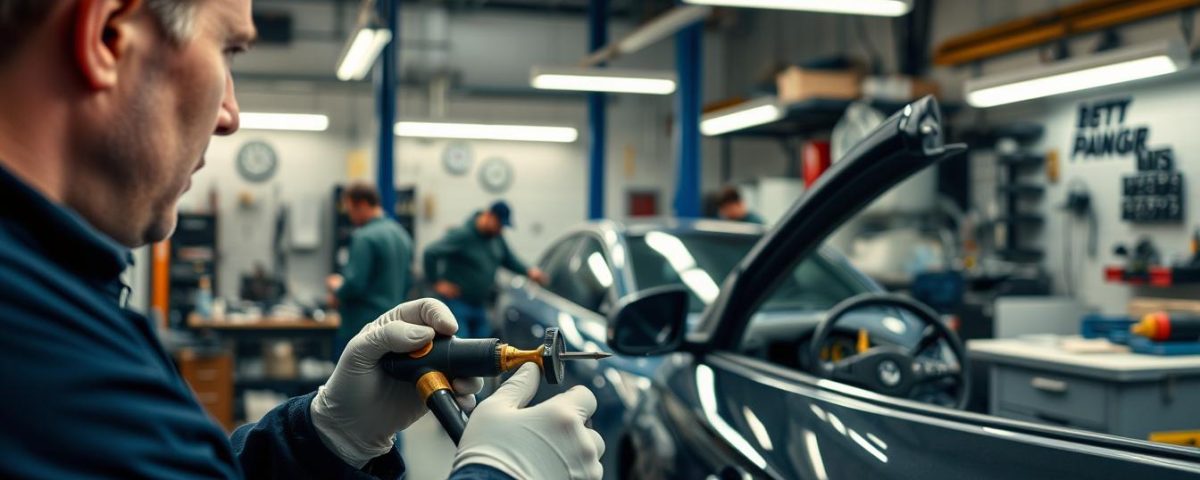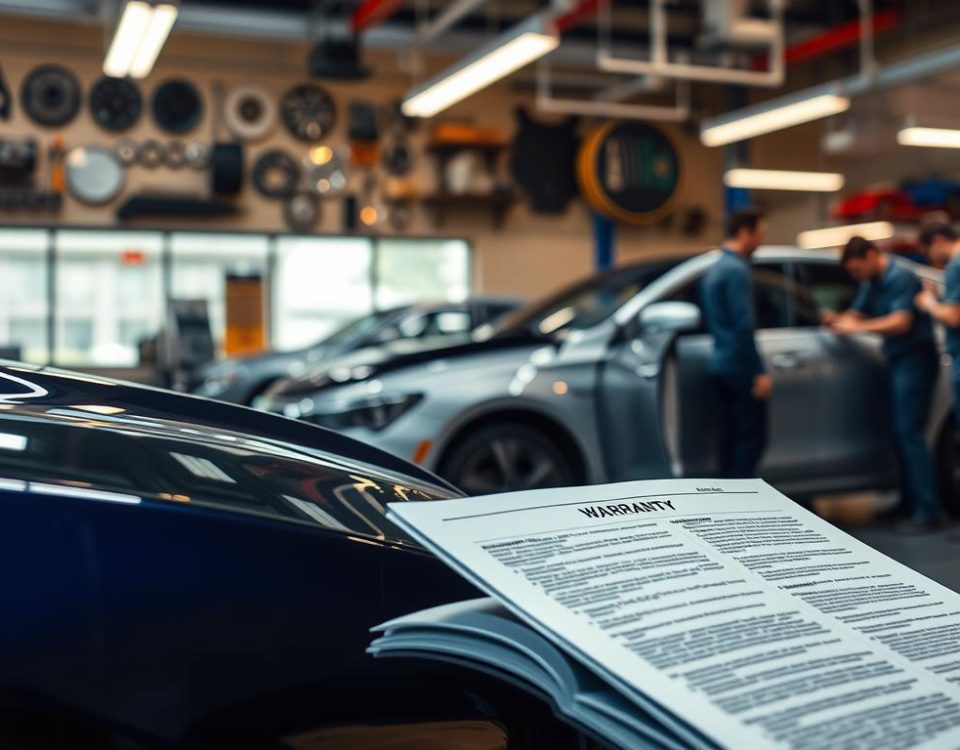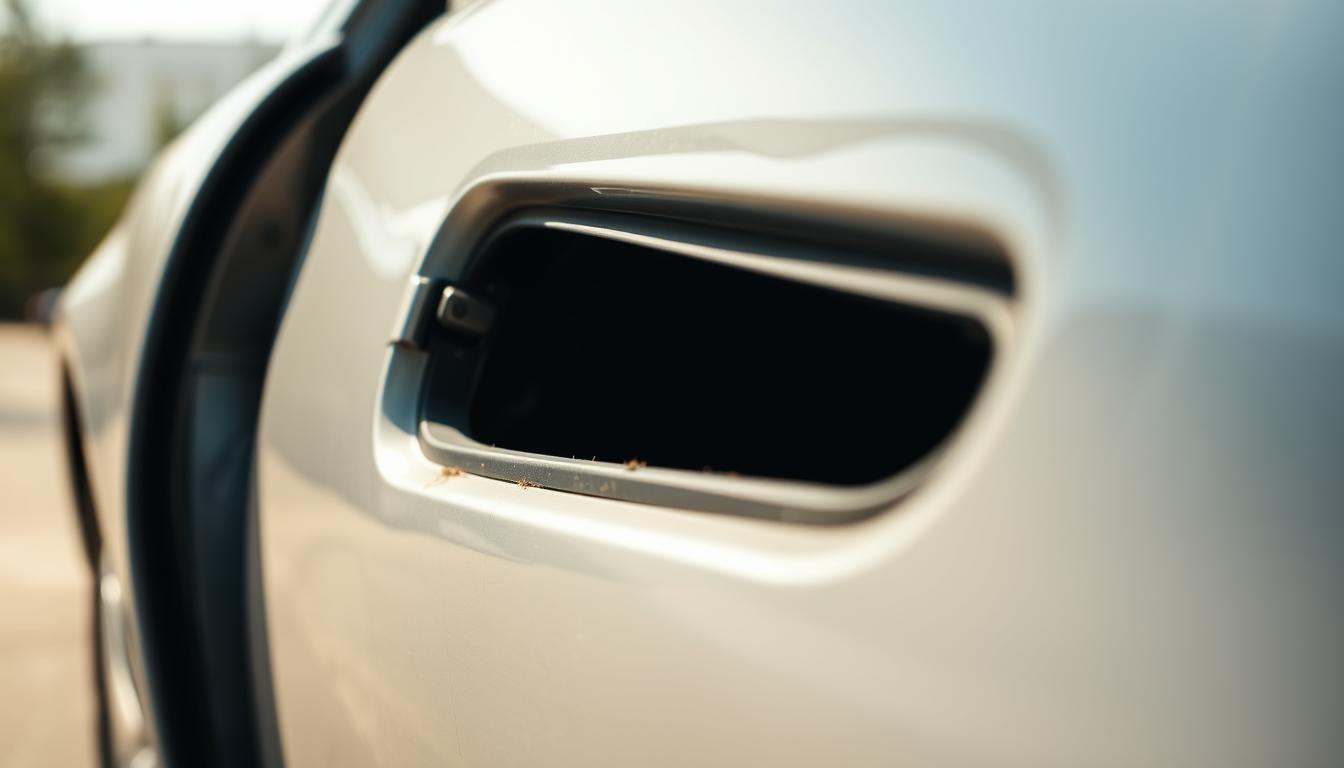
How to Fix a Misaligned Car Door After an Accident
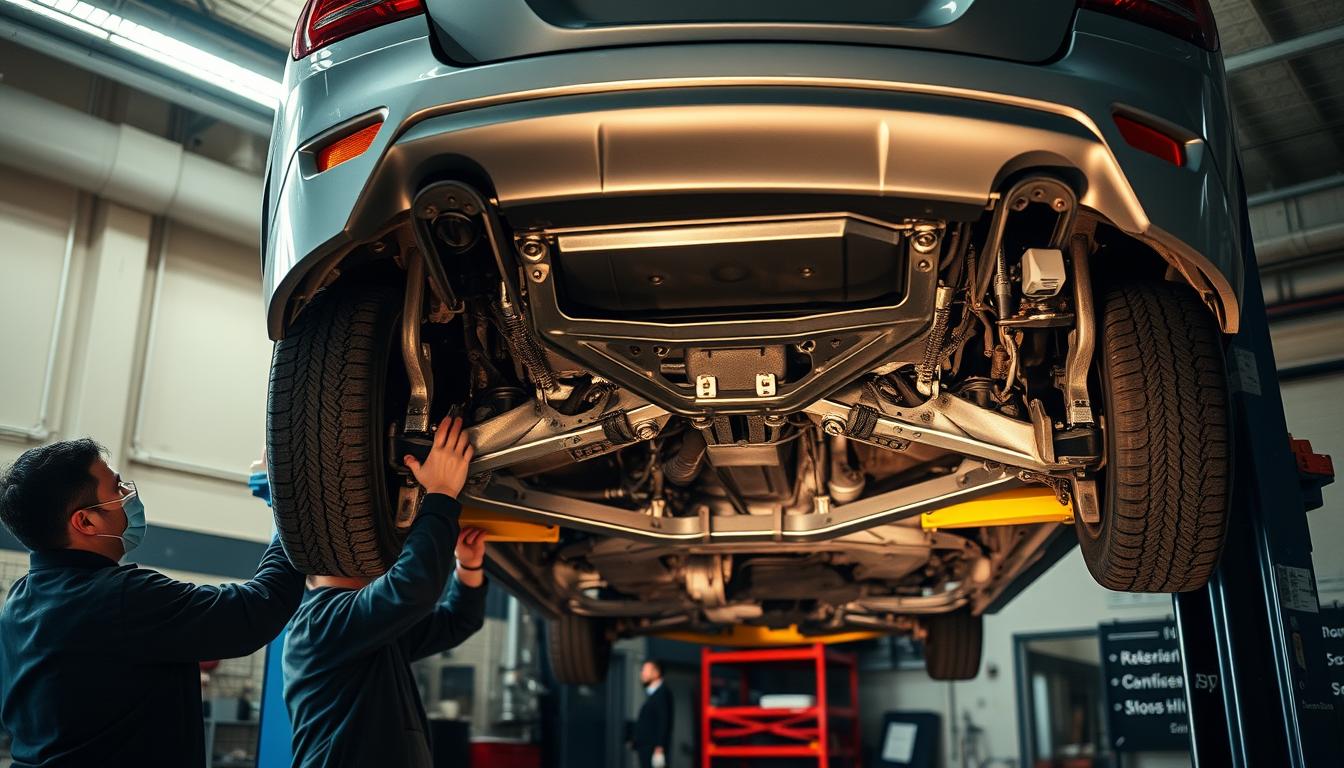
Why a Thorough Frame Inspection is Crucial After a Crash
Keeping our cars in good shape is important. Dents can make our cars look bad and cause more problems if we don’t fix them. Learning how to fix dents helps keep our cars looking great and their value high.
We will talk about different ways to remove dents. This includes paintless dent repair, old methods, and things you can do yourself. We want to help you find the best way to fix your car’s dents.
Key Takeaways
- Addressing dents promptly can prevent further issues.
- Understanding different dent repair techniques is vital.
- Paintless dent repair is an effective option for minor dents.
- Traditional methods may be necessary for more severe damage.
- DIY dent removal can be a cost-effective solution for small dents.
- Choosing the right approach can maintain your car’s value.
Understanding Common Car Dents
Our cars can get damaged fast. We see many types of dents that hurt the car’s look and value. Knowing about these dents helps us fix them right.
Types of Dents We Encounter
Car owners face many common dents. These include:
- Door dings: Small, shallow indentations often caused by other vehicle doors.
- Hail damage: Numerous dents resulting from hail storms, affecting the car’s surface significantly.
- Collision-related dents: Larger, more substantial dents occurring from accidents or impacts.
Causes of Car Dents
Many things can cause dents on our cars. Some reasons include:
- Weather impacts: Hail or extreme weather can inflict damage on our vehicles unexpectedly.
- Parking accidents: Minor collisions in parking lots often result in dings and dents.
- Fender benders: Small accidents that might not seem severe can still leave their mark on our cars.
Identifying the Best Repair Methods
Choosing the right fix for each dent is key. We have options like:
- Paintless dent repair: Ideal for minor dents without damaging the paint.
- Traditional dent repair: Suitable for more extensive damage requiring repainting.
- DIY techniques: For smaller, less complicated dents that we can handle at home.
Paintless Dent Repair (PDR)
Paintless dent repair (PDR) is a cool way to fix small dents and dings on cars. It’s better than old ways of fixing dents. It keeps your car’s paint looking new.
Benefits of PDR
PDR has many good points. Here are a few:
- Cost-effectiveness: It’s cheaper than going to a body shop.
- Time efficiency: Fixes are often done in just a few hours.
- Preservation of the original paint: It keeps your car’s paint looking great.
- Environmental friendliness: It’s better for the planet because it doesn’t use a lot of paint or materials.
The Process We Use
First, we check the damage carefully. Then, our experts use special tools to fix the dent. They press the metal from the back to fix it without hurting the paint.
When PDR is Best
PDR works best for certain kinds of damage. Like:
- Small dents and dings that don’t hurt the paint
- Dents from hail or small accidents
- Shallow dents in easy-to-get-to spots
But, it’s not for deep dents or when paint needs fixing. Then, we’ll find other ways to make your car look new again.
Traditional Dent Repair Techniques
We use old ways to fix your car back to new. These methods are key for big damages. We use special tools to make sure the job is done right.
Common Tools We Utilize
We use many tools for fixing dents. These include:
- Body filler for fixing small flaws
- Dent pulling equipment to fix metal
- Hand tools like hammers for small jobs
How We Restore Your Car’s Finish
Fixing the car’s look is important. We sand and prime the paint area first. Then, we match the paint color and add a clear coat for a perfect finish.
Situations Requiring Traditional Methods
Some dents need old-school fixing. Big damages that hurt paint and metal need these methods. Deep dents or many dents on the car are best fixed this way.
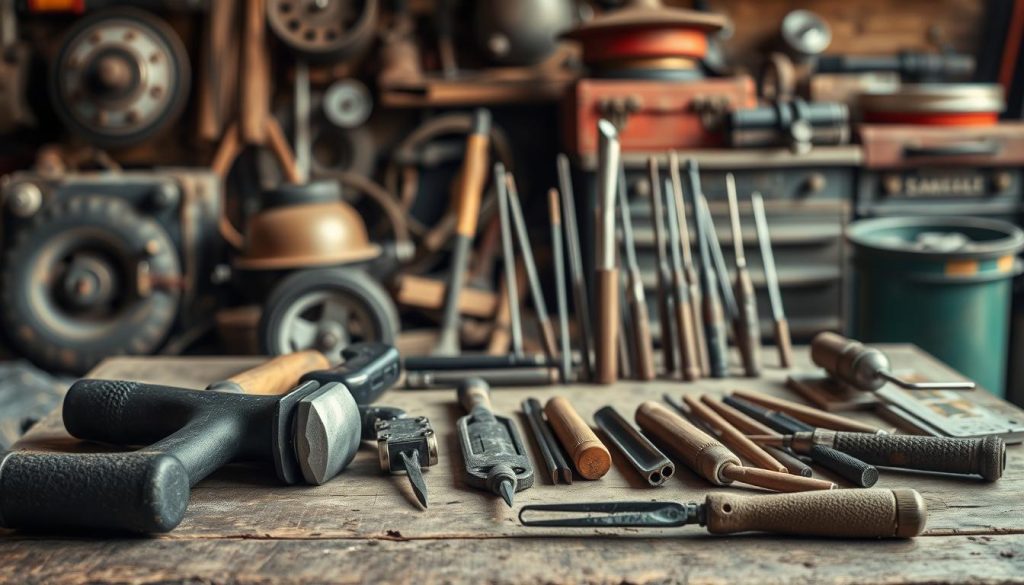
DIY Dent Repair Options
If you’ve found small dents on your car, you might consider using DIY dent repair techniques. These methods can be effective for minor imperfections. They can save you time and money. With the right approach, we can tackle these issues ourselves and restore our vehicle’s appearance.
Basic Techniques for Small Dents
Some straightforward DIY dent repair techniques can make a significant difference. We often recommend using hot water combined with suction cups for small dings. The process is simple:
- Start by boiling water and pouring it over the dent area to soften the metal.
- Attach a suction cup to the dent and pull gently until the dent pops out.
- If the dent is stubborn, we can use a hairdryer to heat the area before attempting the suction method again.
Tools You Might Need at Home
It’s helpful to have some essential home repair tools on hand. Some common tools can aid us in our DIY efforts:
- A hairdryer for heating the metal
- A plunger for pulling out minor dents
- Suction cups specially designed for dent repair
- Soft cloths to protect your car’s finish
When to Seek Professional Help
While many small dents can be handled at home, knowing when to seek professional dent repair is crucial. If we encounter larger or complex dents, the expertise of a professional is needed. This ensures the repair is done correctly. Some situations warrant a specialist’s touch, like paint damage or if the denting affects the vehicle’s structure.
Finding the Right Dent Repair Service
Choosing a dent repair service can be hard. There are many options. We can help you pick the best one for your car.
What to Look for in a Shop
When looking for a shop, think about these things:
- Experience: Choose a shop known for good dent repairs.
- Specialization: Pick a service that knows how to fix your dent type.
- Service Quality: A good reputation means they do great work.
Checking for Certifications and Reviews
Checking certifications shows a shop is professional. Reading reviews tells us about their past work. Look online and on social media to see if they’re reliable and good.
Importance of Customer Service
Good customer service is key. Shops that care about you will be clear and quick to answer. Look for places that are friendly and help you understand what they do.
Preventing Future Dents
Preventing car dents is key. Keeping our cars looking good starts with safe parking and regular care. Safe parking tips and protective products help a lot.
Tips for Parking Safely
Safe parking tips can help avoid dings. Here are some tips:
- Choose parking spots away from busy areas to avoid accidents.
- Pick spaces with extra room for more safety.
- Be careful not to park too close to other cars.
- Reverse parking helps you see better when leaving.
The Importance of Regular Maintenance
Regular car checks keep it running well and spot problems early. Watching your car helps catch small issues before they get worse. A full check-up is key to finding weak spots.
Protective Products We Recommend
Protective products shield our cars from harm. Here are some good ones:
- Car covers block dust, debris, and weather.
- Paint protection films soak up impacts and stop scratches.
- Clear bra installations protect bumpers and hoods from damage.
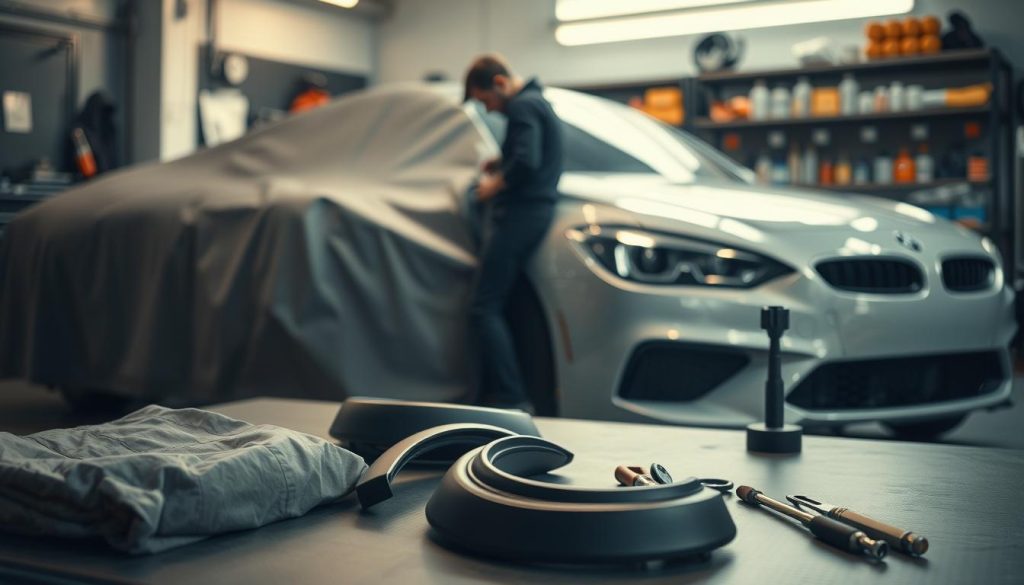
Cost of Dent Repair Services
The cost of fixing dents can change a lot. Knowing what affects prices helps us choose wisely. Let’s look at some important points.
Factors Influencing Pricing
Several things affect dent repair costs, including:
- Dent size: Smaller dents cost less than big ones.
- Location: Dents in hard spots cost more because they’re harder to fix.
- Repair method: Choosing paintless dent repair or traditional methods changes the price.
Comparing DIY vs Professional Costs
Some people try to fix dents themselves to save money. But, DIY can lead to more damage. This can make the repair cost go up.
On the other hand, hiring a pro might cost more upfront. But, they do a better job and keep your car’s value up.
Value of Professional Services
Choosing professional dent repair has big benefits. Experts know what they’re doing and do it well. We feel better knowing our car is in good hands.
Looking at the cost and quality of service helps us make the best choice.
Frequently Asked Questions About Dent Repair
Car owners often wonder about dent repair. Knowing the answers to common questions can help. We’ll talk about repair time, paint safety, and the types of dents we can fix.
How Long Do Repairs Typically Take?
Repair time depends on the dent’s size and where it is. Small dents might take a few hours. But bigger ones could need a whole day or more.
Our team works fast to get your car fixed quickly. We make sure it’s done right, without rushing.
Will My Car’s Paint Be Affected?
Many worry about paint safety during repairs. Luckily, most dents can be fixed without touching the paint. If we need to use other methods, we’re careful to protect your car’s finish.
We aim to make your car look like new. And we do it without damaging the paint.
Can All Dents Be Repaired?
We can fix many dents, but not all. The dent’s depth, location, and paint condition matter. We’ll check your car and tell you the best way to fix it.
Why Choose Miracle Body and Paint for Dent Repair?
We are proud of our dent repair skills at Miracle Body and Paint. Our team works hard to make your car look new again. We use the best tools and methods to do this.
We have lots of experience. This means your car gets the best care. We are a trusted name in the business.
Our Expertise in Collision Repair
At Miracle Body and Paint, we fix all kinds of car damage. Our techs are very good at fixing dents, big or small. They work fast and carefully.
Your car is very important to you. We make sure you are happy with our work. We keep you updated on your car’s repair.
Locations and Availability
We have two places in San Antonio where you can come. You can find us at 6217 Grissom Rd. (210) 680-1987 or 8026 Webbles Dr. (210) 858-3630. Our team is ready to help you fix your car.
Whether you go to our NW or NE location, we will make your car good as new. We want to get your car fixed fast.


